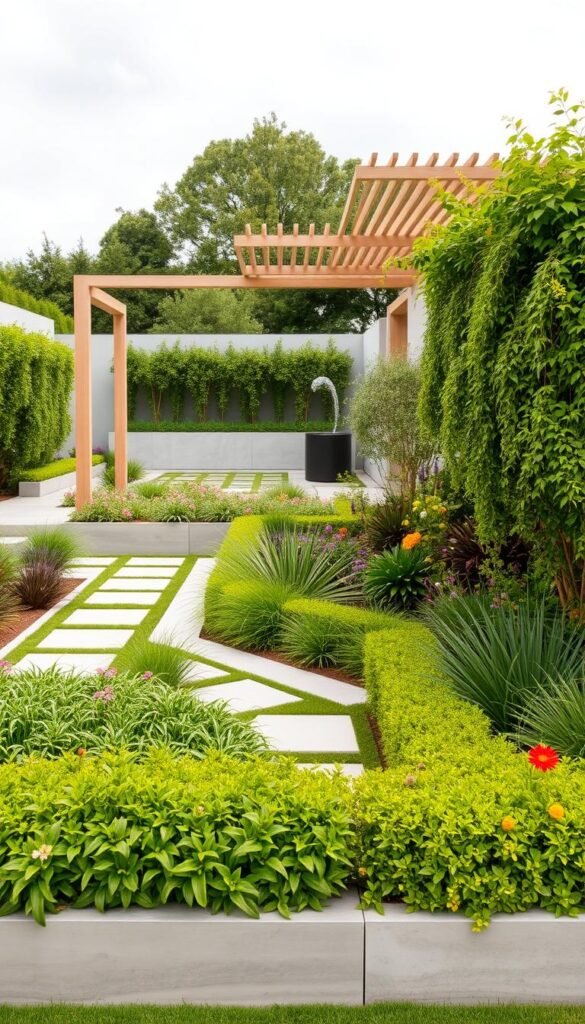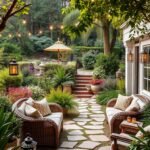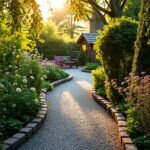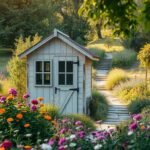This year brings exciting shifts in how we shape our yards and patios. Homeowners are blending style with purpose, creating spaces that refresh both the land and the spirit. You’ll find these ideas balance visual charm with earth-friendly practices, making every square foot work smarter.
Many outdoor areas now serve as personal retreats and wildlife havens. Think native plants that attract butterflies, or rainwater systems that nourish flower beds. These approaches solve common issues like water waste while adding natural beauty to your property.
What makes today’s methods stand out? They adapt to your life. Whether you have acres or a tiny balcony, you can grow food, support pollinators, or craft a calming nook. Even beginners can try modular planters or drought-resistant grasses that thrive with minimal care.
The best part? These concepts aren’t just pretty – they’re built to last. You’ll discover how layered planting protects soil and how seating areas double as stormwater filters. It’s about creating spaces that evolve with the seasons while staying stunning through the years.
Exploring the Wellness and Mental Benefits of Gardening
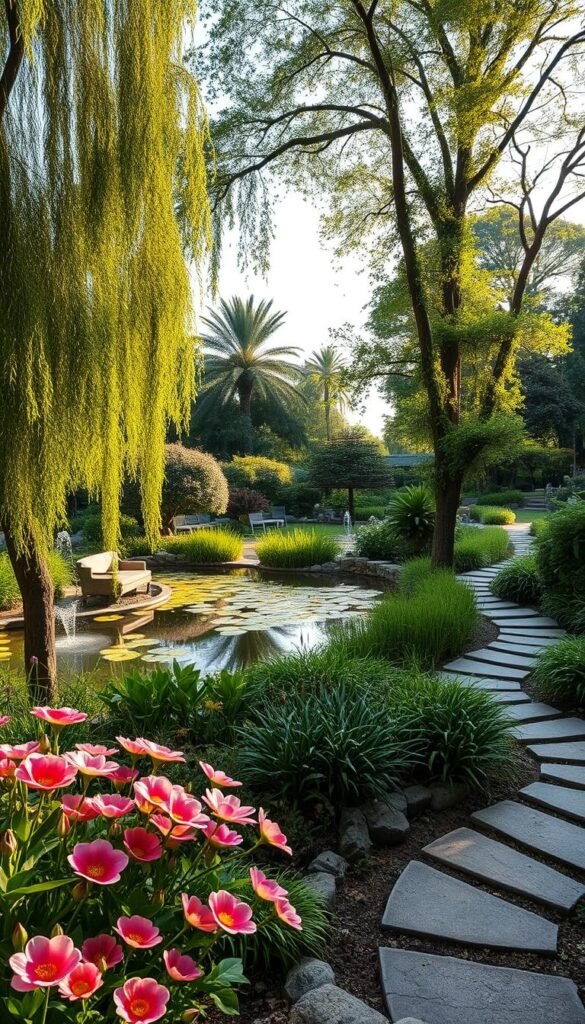
Your backyard could be the key to reducing stress and enhancing daily joy. Science shows that interacting with nature lowers cortisol levels while boosting creativity – a perfect antidote to screen fatigue.
Water Walls and Scented Sanctuaries
Three elements transform ordinary spaces into healing retreats:
| Element | Benefit | Example Plants |
|---|---|---|
| Moving Water | Masks urban noise | Miniature fountains |
| Aromatic Herbs | Triggers calmness | Lemon balm, rosemary |
| Textured Foliage | Encourages touch | Silver mound Artemisia |
The gentle babble of a wellness garden water feature works like white noise for your brain. Research reveals it can lower blood pressure by 9% in just 15 minutes of exposure.
Green Therapy in Action
Ever notice how pulling weeds feels oddly satisfying? That’s “soft fascination” – your brain entering a restorative state through simple tasks. Pro tip: Plant lavender near seating areas – its scent reduces anxiety by 45% according to NIH studies.
“A garden should make you feel you’ve entered privileged space – a place not just set apart but reverberant.”
For those seeking gardening aesthetic ideas, try circular seating arrangements with feather grass borders. The curved lines mimic natural landscapes, enhancing your sense of connection to the environment.
Sustainable and Resilient Garden Design Trends
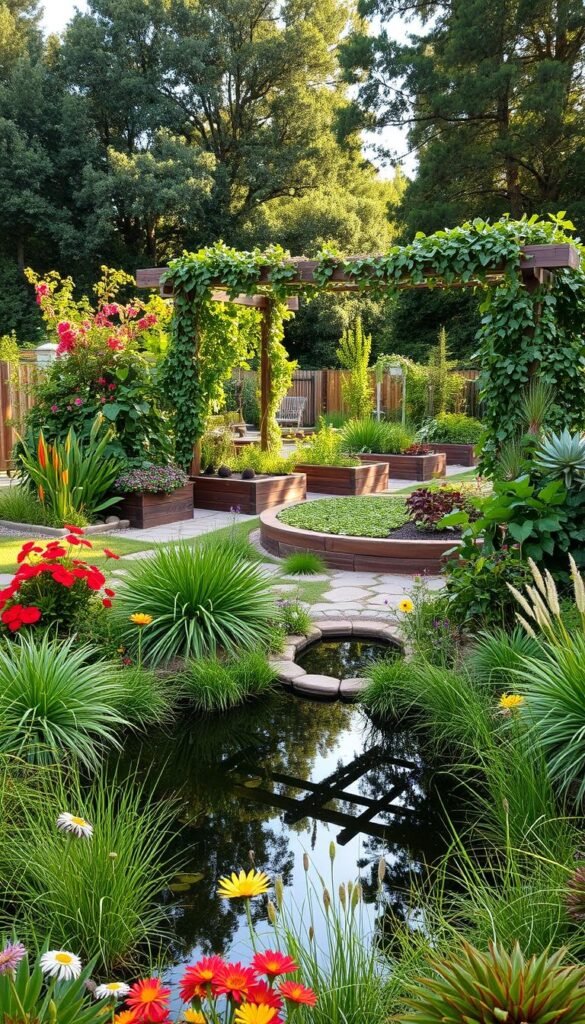
As climate patterns shift, your outdoor space needs smart solutions that work with nature’s rhythms. Today’s approaches combine beauty with built-in toughness, helping your greenery thrive through heatwaves, droughts, or unexpected weather events.
Fire-Resistant Features and Low-Water Landscaping
Protect your property while keeping it picturesque. Fire-resistant plants like Sago palm and Oregon grape have thick leaves that resist ignition. Pair them with gravel pathways and stone walls to create natural firebreaks.
| Plant Type | Water Needs | Key Benefit |
|---|---|---|
| Grevillea | Low | Colorful blooms |
| Blue Hibiscus | Moderate | Drought-resistant |
| Kangaroo Paw | Very Low | Unique texture |
Modern low-water landscapes burst with life. Try feathery yarrow or velvety catmint for cottage charm without the thirst. Pro tip: Group plants by water needs to simplify irrigation.
Choosing Resilient Plants for Harsh Environments
Some species laugh at adversity. Ginkgo trees survive urban pollution, while switchgrass shrugs off poor soil. These champions adapt to your local challenges:
- Redbud trees: Handle temperature swings
- Coneflowers: Resist pests naturally
- Honeylocust: Thrives in compacted earth
By selecting these tough performers, you’ll spend less time babying your garden and more time enjoying it. Resilient landscapes age like fine wine – getting better each season.
Top Contemporary Garden Design Trends to Watch This Year
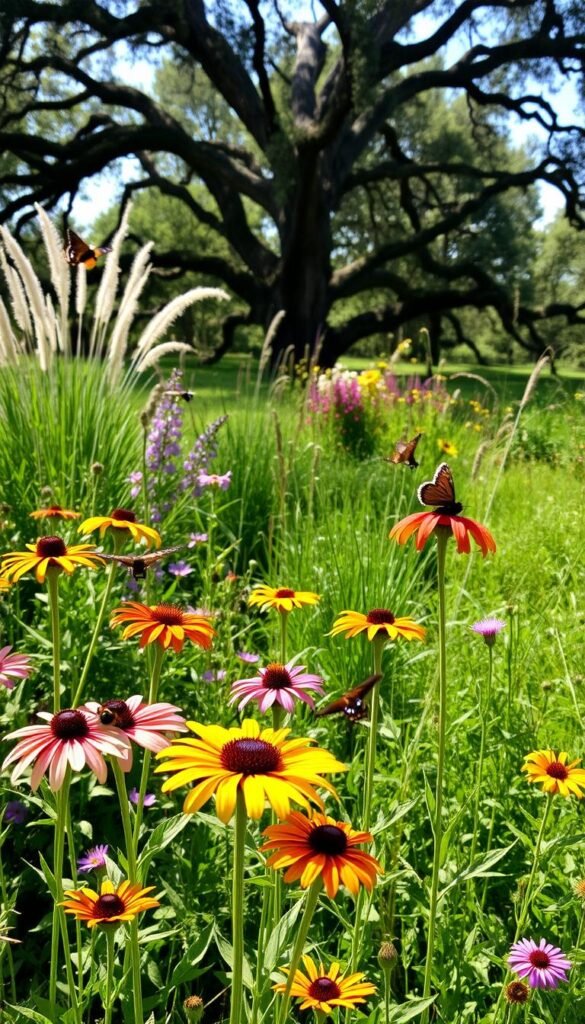
Your garden is becoming a frontline defender for local ecosystems. A quiet revolution grows as native plants take center stage in modern landscapes. These species evolved alongside regional wildlife, forming partnerships that keep nature balanced.
Why Native Cultivars Make Sense for Modern Spaces
Breeders now offer upgraded versions called nativars – native plants fine-tuned for home use. These hybrids keep their ecological superpowers while fitting neatly into designed spaces. Imagine milkweed that stays compact or coneflowers with vibrant sunset hues.
| Feature | Wild Native | Nativar |
|---|---|---|
| Height | Variable | Controlled |
| Bloom Color | Natural | Enhanced |
| Water Needs | Adaptive | Optimized |
This trend solves a common dilemma: how to support bees and butterflies without your yard looking wild. The solution? Plants that please both humans and pollinators.
Smart gardening means staggering bloom times. Early-blooming phlox feeds spring bees, while goldenrod fuels fall migrations. You’ll create all-season buffets with minimal effort.
“When we plant natives, we’re not just gardening – we’re rebuilding food webs one yard at a time.”
Your choices ripple outward. Neighborhoods rich in native plants see 60% more pollinator visits. It’s a living design strategy that beautifies while healing the land.
Innovative Planting Techniques and Native Plant Selections
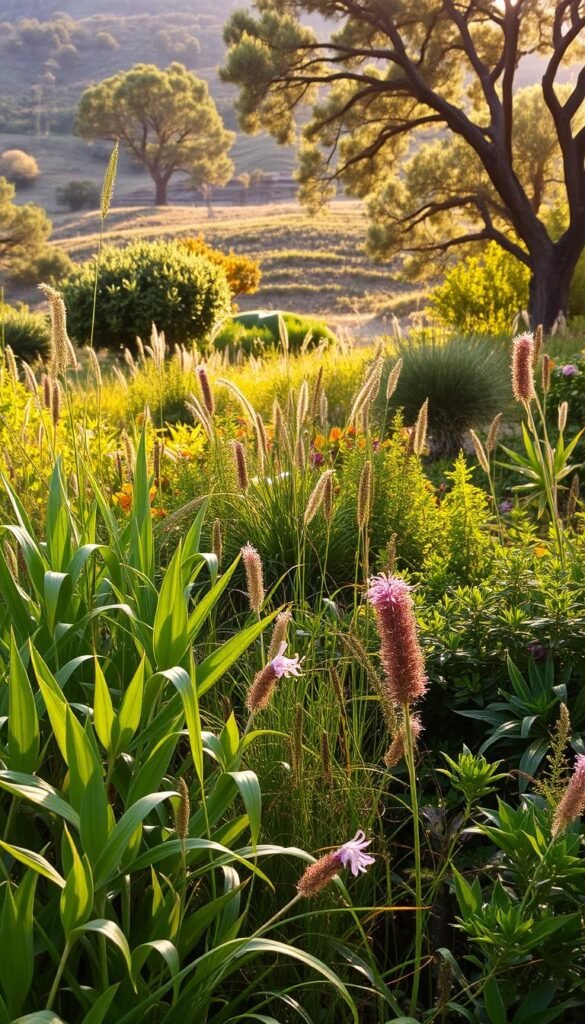
Your landscape is getting a smart upgrade through plant science breakthroughs. Breeders now craft native cultivars that thrive in modern settings while keeping their wildlife-supporting powers. These nativars offer the best of both worlds – ecological benefits paired with garden-friendly traits.
Utilizing ‘Nativars’ for a Modern Garden Aesthetic
Traditional breeding focused on flashy blooms. Today’s techniques prioritize practical improvements for residential spaces. Compact milkweed varieties stay tidy, while drought-tolerant coneflowers bloom longer with minimal water.
| Trait | Wild Native | Nativar |
|---|---|---|
| Height Control | Unpredictable | Consistent |
| Water Efficiency | Adaptive | Optimized |
| Seasonal Interest | Short bloom | Extended display |
Your maintenance routine gets easier too. Letting seed heads stand through winter feeds birds and shelters beneficial insects. Faded perennials add texture – a goldenrod’s skeletal form becomes winter art.
Try matrix planting for low-effort beauty. Layer groundcovers like sedge grass under taller native plants. This living carpet suppresses weeds while creating habitat corridors. As one plant fades, another takes center stage.
“A garden isn’t finished when the last petal falls – that’s when its second act begins.”
These techniques help your space evolve gracefully. You’ll create gardens that work smarter, support ecosystems, and charm neighbors across seasons.
Designing Dynamic Spaces: From Modern Meadows to Bold Color Schemes
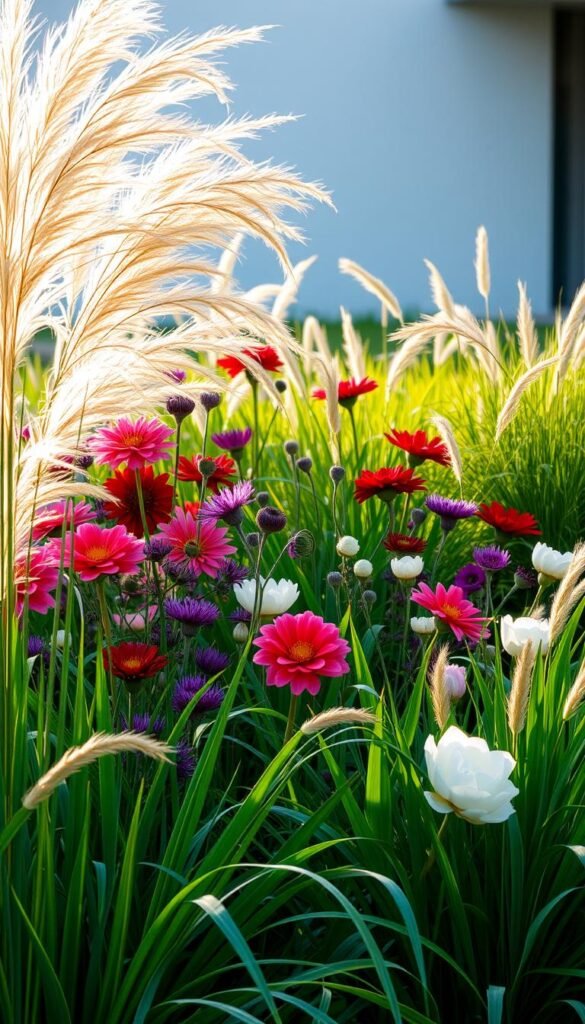
Transform your outdoor areas into living canvases that shift with the season. Modern meadows capture nature’s energy while keeping things tidy through strategic plant choices. Imagine billowing grasses cradling bursts of coneflowers – wild enough to charm butterflies, structured enough to please neighbors.
Balancing Structure and Spontaneity
The matrix planting method turns your garden into a layered masterpiece. Start with low-maintenance grasses like blue fescue as your base. Weave in flowers like achillea and salvia that punch through this green carpet with fiery oranges or deep purples.
Bold color schemes make spaces sing without overwhelming. Pair electric pink roses with snowy hydrangea blooms for contrast. Add structural shrubs like boxwood to anchor the vibrancy – they’re the quiet heroes keeping your design grounded.
“A garden should thrill the senses in July and whisper secrets in January.”
These approaches thrive through seasonal changes. Switchgrass turns gold in fall, while sedum’s foliage offers winter texture. For inspiration on blending wild and curated elements, explore current design trends that celebrate this balance.
Your spaces become dynamic showstoppers when you mix movement and stability. Let tall maiden grass sway beside sturdy lavender spikes. This contrast creates visual rhythm, proving organized chaos can coexist beautifully – a concept explored in personal gardening style guides.
Romancing Your Outdoor Space with Edible Garden Elements
Your outdoor area can become a feast for the senses when food plants mingle with flowers. This fresh approach lets you harvest meals while crafting eye-catching displays. Beauty meets practicality as herbs frame pathways and berry bushes double as living sculptures.
Blending Ornamentals with Edibles for Nostalgic Charm
Picture ruby-hued strawberries spilling between peony blooms or rosemary’s blue flowers accenting rose bushes. These pairings create garden moments that feel both new and familiar. Thyme makes a fragrant carpet under hydrangeas, while purple basil adds drama to white phlox arrangements.
Many clients now seek this mix of function and sentiment. They’re tucking blueberry shrubs into flower borders and training grapevines over arbors. The result? Spaces that whisper of grandmother’s home garden but work seamlessly in modern landscapes.
Crafting a Productive Potager Paradise
The updated French potager style proves vegetable patches needn’t be plain. Arrange rainbow chard in geometric patterns or let nasturtiums cascade from raised beds. Pro tip: Use edible flowers like calendula to add pops of color among your greens.
For ideas that merge creativity with harvests, explore unique outdoor decor strategies. You’ll discover how kale’s ruffled leaves complement dahlias, or how mint’s spreading habit fills gaps between paving stones beautifully.
This trend transforms every square foot into dual-purpose magic. Your morning coffee spot might feature chamomile creeping through cracks, while evening dinners showcase salads picked from floral borders. It’s gardening that nourishes body and soul in equal measure.

